Tuesday, June 20, 2006
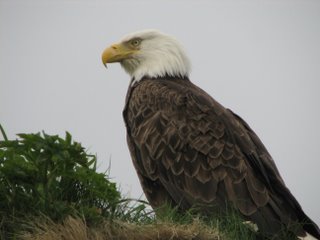
NOAA Teacher At Sea: Jacob Tanenbaum
NOAA Ship MILLER FREEMAN
Mission: Bering Sea Fisheries Research
Day 20: June 20, 2006
Ship Status: At Port
Personal Log
Click here if you would like to look at the results from the Pollock Study.
This will be my last blog entry for the trip. As the project draws to a close, I would like to evaluate how effective it was. There is a link to an electronic survey. I would like to ask students, teachers, parents, and other visitors to the site to take a few moments to let me know what you think of this idea. The survey is all electronic and only takes a minute or two to complete. Thank you in advance for your time. Click here to access the survey.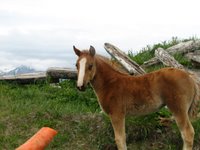 Today we arrived in the port of Dutch Harbor, Alaska early this morning. Dutch Harbor is a fishing village full of interesting sites to see and people to meet. It is also where the fishing vessels featured in the TV show “Deadliest Catch” are based, so a lot of you may have heard of it.
Today we arrived in the port of Dutch Harbor, Alaska early this morning. Dutch Harbor is a fishing village full of interesting sites to see and people to meet. It is also where the fishing vessels featured in the TV show “Deadliest Catch” are based, so a lot of you may have heard of it.
The highlights of an incredible day were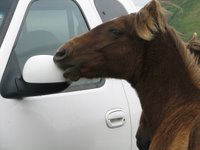
A herd of wild horses. Their ancestors were released here by US soldiers stationed here after World War 2. We couldn't figure out what they ate until... :)
More eagles than I have ever seen (click here for a video).
Climbing in mountains full of wildflowers.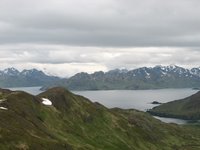
Snow!!
An incredible end to an incredible journey. Thanks all of you for sharing it with me.
Final Thoughts:
I would like to express my profound appreciation to everyone on board NOAA Ship MILLER FREEMAN. Every single person on board the ship welcomed me and helped me in every possible way with this project. The scientists and ships personnel answered every one of mine and your thousands of questions and opened the entire ship up to us all. Many of the people on board shared the blog with their families back home, and the notes I have gotten back from them touched me deeply.
To Commander Gallagher, Lieutenant Commander Boland, Dr. Paul Walline and the everyone on board, thank you for making this project possible and for all you have done to welcome me on board the ship these past weeks.
Thank you as well to the Jennifer Hammond, Elizabeth McMahon and everyone at the Teacher At Sea program for creating this wonderful opportunity and for all of your support before and during the project.
Thank you as well to all of you back home for taking part in this experiment. Teaching and learning with you from the Bering Sea has been one of the most rewarding experiences of my 19 years as an educator.
Have a great summer vacation everyone.
Monday, June 19, 2006
NOAA Ship MILLER FREEMAN

Mission: Bering Sea Fisheries Research
Day 19: June 19, 2006
Weather Data from the Bridge:
Visibility: Less than 1 mile
Wind Speed: 14 miles per hour
Sea Wave Height: 2 feet
Water Temperature: 44.06 degrees
Air Temperature: 41.36 degrees
Pressure: 1018 Millibars
Personal Log
NOTE: We will arrive in the port of Dutch Harbor, Alaska on June 20. As the project draws to a close, I would like to evaluate how effective it was. There is a link to an electronic survey. I would like to ask students, teachers, parents, and other visitors to the site to take a few moments to let me know what you think of this idea. The survey is all electronic and only takes a minute or two to complete. Thank you in advance for your time. Click here to access the survey. I should be able to send one more blog tomorrow from Dutch Harbor. Check back and I will let you know what being on land again feels like. Dutch Harbor should be an interesting place.
We passed the Pribilof Islands. Home to one of the largest worlds largest gatherings of marine mammals in the summer time. I got up to see the islands at midnight and again when we passed a second one at 4:00 AM. We were covered in fog both times, so we will have to come back another day. At midnight, the sun had not yet set. Our sun set last night at about 12:15 and it took a long time to grow dark after that. The sky began to grow light at about 5:00 and it came up a little after 6. A short night.
Science Log
Last night we had another bottom trawl. This one had some of the largest sea stars I have ever seen. One was close to a foot long. Take a look.
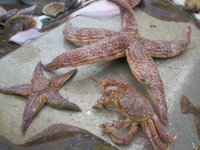
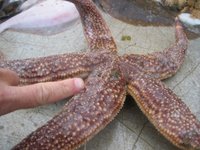
In addition, there is a coral here called sea raspberry. It is common along the Bering Sea Shelf. I thought coral was only in tropical seas, but here it is in the Bering Sea.
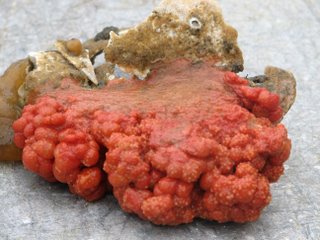
Since it is our last day at sea, I spoke to our Chief Scientist Dr. Paul Walline from the Alaska Fisheries Science Center in Seattle Washington about what we have learned so far.
What does the data tell you so far?
What do you expect to see in the next legs?
What will happen to the data at the end of the cruise?
Finally, we were testing a platform today that can open nets at different depths. We lowered the
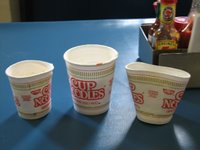 platform to about 390 feet before a technical problem forced us to raise it back up to the surface. As an experiment of my own, I tied a bag of Styrofoam cups to the platform to see what the pressure at that depth would do to them. Want to see more? Click here for a video
platform to about 390 feet before a technical problem forced us to raise it back up to the surface. As an experiment of my own, I tied a bag of Styrofoam cups to the platform to see what the pressure at that depth would do to them. Want to see more? Click here for a videoQuestion of the Day:
What was your favorite part about participating in this project. Please write and let me know.
Photos
Saint Paul Island in the Pribilof Islands seen through the fog
Sea stars and crabs from a bottom trawl
Sea star from a bottom trawl
Red Raspberry Coral
Sunday, June 18, 2006
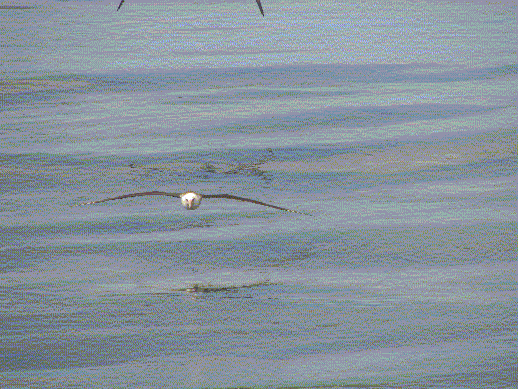
NOAA Ship MILLER FREEMAN
Mission: Bering Sea Fisheries Research
Day 18: June 18, 2006
Weather Data from the Bridge:
Visibility: 10 miles
Wind Speed: 9 miles per hour
Sea Wave Height:2 feet
Water Temperature:41 degrees
Air Temperature:40.8 degrees
Pressure: 1013 Millibars
Personal Log
NOTE: We will arrive in the port of Dutch Harbor, Alaska on June 20. As the project draws to a close, I would like to evaluate how effective it was. There is a link to an electronic survey. I would like to ask students, teachers, parents, and other visitors to the site to take a few moments to let me know what you think of this idea. The survey is all electronic and only takes a minute or two to complete. Thank you in advance for your time. Click here to access the survey.
By now, you have met many of the interesting people aboard NOAA ship MILLER FREEMAN. There are three groups of people aboard these ships. The officers on the ship are part of the NOAA Corps. This is a uniformed service of the United States consisting of about 300 officers who complete rigorous training and hold ranks, like ensign, or commander. They are in charge of ships operations and stand watch on the bridge.
The scientists aboard are mostly from NOAA research labs, like the Alaska Fisheries Science Center in Seattle.
Many of the other members of the crew are civilian wage mariners. These are professional
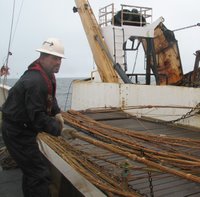 sailors who handle many of the day to day operations of the ship. Some, such as Chief Engineer Bus, have made their home on this ship for close to 30 years. Other sailors are contract workers who come aboard for a few months, go home and take a break, then join the crew of another ship for a different sort of cruise. Sometimes they are on research vessels, sometimes they are on freighters, sometimes they are on tankers. Today, lets meet able-bodied seaman, or AB Michael O’Neal. Click each question to listen to the answer.
sailors who handle many of the day to day operations of the ship. Some, such as Chief Engineer Bus, have made their home on this ship for close to 30 years. Other sailors are contract workers who come aboard for a few months, go home and take a break, then join the crew of another ship for a different sort of cruise. Sometimes they are on research vessels, sometimes they are on freighters, sometimes they are on tankers. Today, lets meet able-bodied seaman, or AB Michael O’Neal. Click each question to listen to the answer.What do you do on board the NOAA Ship MILLER FREEMAN?
Tell us about what you have done and where you have gone on some of the other ships you have been on.
Where are some of the other jobs you have had at sea?
What does it take to be an able-bodied seaman?
Science Log:
We had another in a series of amazing bottom trawls last night. When the nets trawl along the bottom out here, some of the most interesting creatures of all get swept into our nets. Creatures that live on the bottom are often stranger looking for a few reasons. They are adapted to blend into the bottom so that predators cannot see them. They often wind up looking like rocks or plants as a kind of defense. They are also adapted to an environment with higher pressure and less light than the surface. Some of their adaptations can also make them look very different from other fish. Since they don’t have to worry about predators below them, these fish may be flat and have both their eyes sticking up. These creatures often do not need to be fast swimmers, since their defense is to blend into the environment rather than swim away when predators approach.
This basket of sea cucumbers was one of the strangest things I’ve seen so far. These sticky blobs are not plants. They are sea creatures that live on the bottom of the sea and sift through the sand or water to find food. There are several different kinds of sea cucumbers in this basket. Can you see the different types?
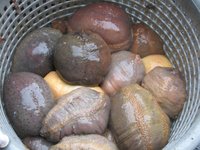
Here is a different kind of sea star than the ones we have found so far. It is called a mud star. It is soft and sticky, not like the sea stars we have at home. It may be called a mud star, but I think looks like Patrick from Sponge Bob.
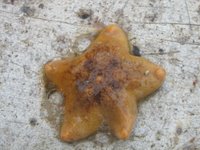
Smile! Here are two photos of big mouth sculpins. Once close up and one in the hands of Dr. Mikhail Stepanenko.
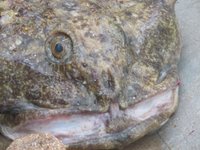

Here is another kind of sculpin with large fins that look like the wings of a butterfly. It is called a Butterfly sculpin.
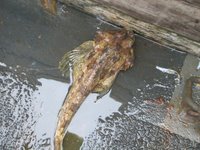
Question of the Day
Now that you have seen some of the different jobs aboard NOAA Ship MILLER FREEMAN, if you were on a ship, which job would you prefer? Write me a comment on the blog and let me know!
Answer to Yesterday’s Question
Look at the movements of the ship described above. When the ship drives into the wind and waves, sailors call it a corkscrew motion. Can you think why?
A corkscrew motion occurs when the ship is struck by waves in such a way that it moves in several motions at once. In other words, it may pitch, roll, surge, and sway all at the same time. I’m getting a funny feeling in my stomach just thinking about it!
Answers to Your Questions
Sorry that I left off the link from Friday where you can see the position of the ship. Here it is. Fair warning, the site was down for most of today, so if it does not work, just try again later.
http://info.nmao.noaa.gov/shiptracker/Ship.aspx?ship=Miller%20Freeman
After we put in to port, I’ll have a day or two in Dutch Harbor to look around, before I can get a flight in to Anchorage. After that, I’ll be visiting some friends and family out west before I head back east. Thanks for writing.
Photos:
An albatross lands in the water behind the ship
AB Michael O’Neal
Photos from a bottom trawl as noted in the blog
Saturday, June 17, 2006
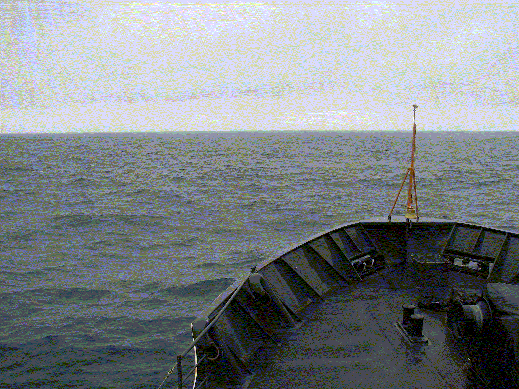
NOAA Teacher At Sea: Jacob Tanenbaum
NOAA Ship MILLER FREEMAN
Mission: Bering Sea Fisheries Research
Day 17: June 17, 2006
Weather Data from the Bridge:
Visibility: 14 miles
Wind Speed: 25 miles per hour
Sea Wave Height 7: feet
Water Temperature: 44.06 degrees
Air Temperature: 44.96 degrees
Pressure: 1009 Millibars
Personal Log
NOTE: We will arrive in the port of Dutch Harbor, Alaska on June 20. As the project draws to a close, I would like to evaluate how effective it was. There is a link to an electronic survey. I would like to ask students, teachers, parents, and other visitors to the site to take a few moments to let me know what you think of this idea. The survey is all electronic and only takes a minute or two to complete. Thank you in advance for your time. Click here to access the survey.
Well, we had pea soup for lunch today, also called storm soup by sailors. Legend is that when you serve pea soup, the weather will turn stormy, and sure enough, a gale is blowing nearby and the waves are picking up. The soup was great, though. As the ship rocks and rolls to the rhythm of the waves, lets take a closer look at how it moves. Sailors have lots of different terms for ships movement:
Pitch – refers to the up and down movement of the front, and back, or bow and stern of the ship
 .
.Yaw -- when the ship spins from side to side.

Heave -- When the entire ship moves up and down.
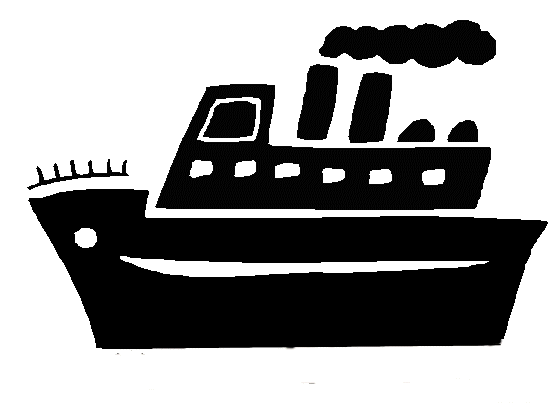
Roll --- When the ship rocks from side to side.

Surge – When the ship jumps forward or backward.
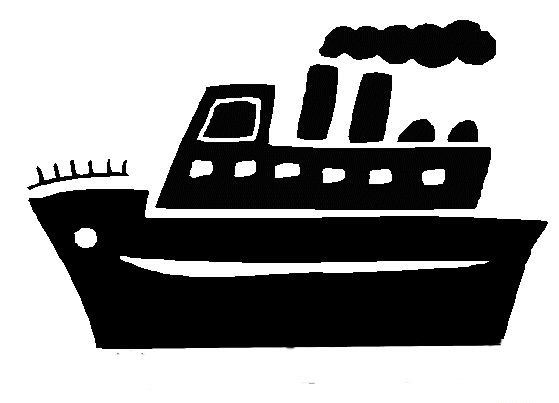
Sway – When the ship jumps sideways.
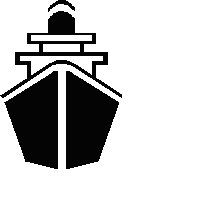
Happy Father’s Day to all. A special hello to my own father, Elias, and my two son’s Nicky and Simon. I miss you, guys.
Science Log
Our trawl nets picked up the smooth lumpsucker fish near the bottom last night.
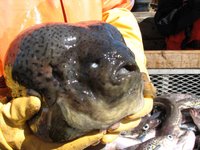 This fish tends to say near the bottom and can inflate itself with water as a defense against predators. A good defense, I would say. Would you want to eat it?
This fish tends to say near the bottom and can inflate itself with water as a defense against predators. A good defense, I would say. Would you want to eat it?Our survey continues. We brought in two hauls of fish this morning. Tamara is having less time on the bridge looking for birds in the last day or so. Her time is limited because we are fishing more and a large group of birds following a fishing net is not considered a natural occurrence, so she does not count them in her study. If the waves are too high, she cannot see the small birds in the troughs of the waves, so she can’t count during heavy seas, and right now, the seas are fairly heavy.
Question of the Day:
Look at the movements of the ship described above. When the ship drives into the wind and waves, sailors call it a corkscrew motion. Can you think why?
Answer to Yesterday’s Question
It is about 8:00 AM on Saturday morning. If the ship uses 2100 gallons of fuel a day, how many gallons of fuel will we need to get to Dutch Harbor on Tuesday Morning at about 8:00 AM?
It will take 3 days to reach Dutch Harbor. Since the ship uses 2100 gallons of fuel a day, we have to multiply 2100 x 3 which equals 6300 gallons of fuel. Enough for my car to drive 157500 miles. Wow.
Answers to Your Questions
Hello to James H from yesterday.
Thanks for writing
Photos
A “bow washer” wave
Smooth Lumpsucker fish.
Orcas from June 12th
Friday, June 16, 2006
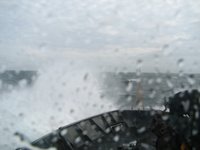
NOAA Ship MILLER FREEMAN
Mission: Bering Sea Fisheries Research
Day 16: June 16, 2006
Weather Data from the Bridge:
Visibility: 14 miles
Wind Speed: 27 miles per hour
Sea Wave Height: 7 feet
Water Temperature: 41.7 degrees
Air Temperature: 42.4 degrees
Pressure: 1013.8 Millibars
Personal Log
NOTE: We will arrive in the port of Dutch Harbor, Alaska on June 20. As the project draws to a close, I would like to evaluate how effective it was. There is a link to an electronic survey. I would like to ask students, teachers, parents, and other visitors to the site to take a few moments to let me know what you think of this idea. The survey is all electronic and only takes a minute or two to complete. Thank you in advance for your time. Click here to access the survey.
How do you find your way around when you can’t see any land? I spent some time with Ensign
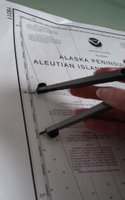 Lindsey Vandenberg, on NOAA Ship MILLER FREEMAN.
Lindsey Vandenberg, on NOAA Ship MILLER FREEMAN. 
Every 30 minutes or so, the bridge officers take a “fix” on their position. How do they do it? When they are out at sea, they take the latitude and longitude from the GPS and plot their exact position on a chart. A GPS is a machine that uses satellites to display the exact longitude and Latitude on a screen. The charts also have the latitude and longitudes written on them, but there is a problem. The longitude and latitudes scales on the chart are on the side and bottom of the chart, not where the ship is located. Every so often, there is a line across the entire chart. The navigator must use a tool, like the same compass you might use in math class, to mark the distance to the exact point on a scale from a line on the chart. She can then use the same tool to mark the distance in the part of the chart where we actually are. This must be done for both the longitude and latitude of the ship.
When we are near land, we can use Terrestrial Navigation. This means we can use the distance
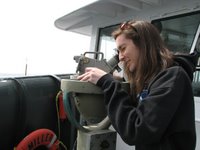 to an object on the shore, such as a lighthouse, to find out where
to an object on the shore, such as a lighthouse, to find out where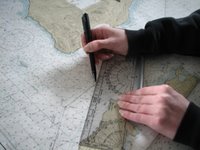 we are. With a large ship close to shore, it is very important that we know exactly where we are so that we don’t wind up in shallow water. Ensign Vandenberg uses a tool called an alidade to help her. She puts the alidade over a large compass outside of the ship. The instrument reflects the compass into the viewer so she can see both the object on shore and the exact compass heading. If she takes a few bearings to objects on shore, she can use tools to chart her exact position on the chart.
we are. With a large ship close to shore, it is very important that we know exactly where we are so that we don’t wind up in shallow water. Ensign Vandenberg uses a tool called an alidade to help her. She puts the alidade over a large compass outside of the ship. The instrument reflects the compass into the viewer so she can see both the object on shore and the exact compass heading. If she takes a few bearings to objects on shore, she can use tools to chart her exact position on the chart.Science Log:
I’ve been asking many of the people on the ship what becomes of the data that we are collecting. This survey will be used to set quotas for one of the most important fisheries in the world. Here is how it works. If too many fish are caught in an area, there will not be enough fish left for the species to come back the next year. That is bad for the fish, and bad for the fisherman. To prevent this “overfishing,”. A quota, or limit to the number of fish that can be safely caught, is established. Methods are put in place to make sure that all fishing boats in the area respect the quotas. Do you want to learn more? Take a look at this short video on the subject.
Question of the Day:
It is about 8:00 AM on Saturday morning. If the ship uses 2100 gallons of fuel a day, how many gallons of fuel will we need to get to Dutch Harbor on Tuesday Morning at about 8:00 AM?
Answers to Yesterday’s Question:
If our ship wants to do a trawl 50 meters below the surface, how much wire would it need.
The ship must put out two feet of wire for every one foot of depth. So you have to multiply 50 x 2 which gives 100 meters of wire. Each net has, not one, but three wires holding it to the ship. So you would need 3 wires. All three are 100 meters in length. That gives us 300 meters of wire to do our trawl.
Answers to Your Questions:
Hello to all who wrote today.
Colin, no seawater on the equipment yet. They have a couple of computers in the lab where we process fish that can be drenched with water and will still work. Maybe I need one of those.
Mrs. Z. Click here to see the route we have taken so far. I do not think it will give you exact miles, but you can get a good idea of our total.
Thanks for writing.
Photos:
Waves washing over the bow of NOAA Ship MILLER FREEMAN
Ensign Lindsey Vandenberg, on NOAA Ship MILLER FREEMAN shows us how to navigate:
-- Plotting longitude and latitude (2 photos).
-- Taking a bearing with an alidade.
-- Ploting the bearing on a map.
Thursday, June 15, 2006
NOAA Ship MILLER FREEMAN
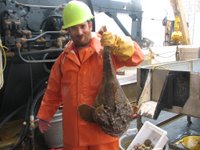
Mission: Bering Sea Fisheries Research
Day 15: June 15, 2006
Weather Data from the Bridge:
Visibility: 14 miles
Wind Speed:19.5 miles per hour
Sea Wave Height: 4 foot
Water Temperature: 44.4 degrees
Air Temperature: 44.2 degrees
Pressure: 1018.8 Millibars
Personal Log
I got to thinking the other day that the engines on this ship have been running since we left port almost two weeks ago now. I started to wonder how they could stay running for so long and so I decided to ask Chief Engineer Steve Bus to tell me more about them. So put on your ear protection, and lets go to the engine room.
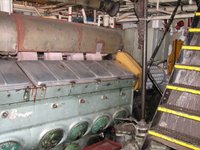 The engine room on NOAA Ship MILLER FREEMAN is like a
The engine room on NOAA Ship MILLER FREEMAN is like a 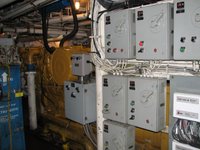 small city below the deck. In addition to the 2100 horsepower diesel engine that moves the ship forward, there are generators sufficient to power a small town. A research vessel, after all, needs a lot of electricity to run all the electronics we need. In addition, the engine room has equipment to make it’s own drinking water out of sea water. We cannot drink sea water because it has too much salt for our bodies to handle. The machines in the engine room take the salt out of the water and, clean it, and make it possible for us to drink it. There are boilers to heat water and make steam to keep the ship warm. There are also machines that process waste water. Finally, there is shaft alley. This is the part of the
small city below the deck. In addition to the 2100 horsepower diesel engine that moves the ship forward, there are generators sufficient to power a small town. A research vessel, after all, needs a lot of electricity to run all the electronics we need. In addition, the engine room has equipment to make it’s own drinking water out of sea water. We cannot drink sea water because it has too much salt for our bodies to handle. The machines in the engine room take the salt out of the water and, clean it, and make it possible for us to drink it. There are boilers to heat water and make steam to keep the ship warm. There are also machines that process waste water. Finally, there is shaft alley. This is the part of the 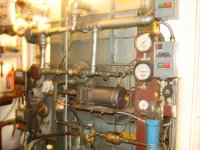
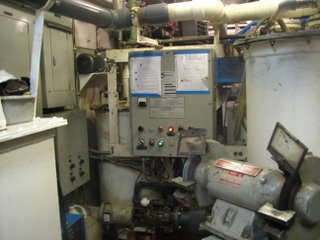 engine room where a long metal shaft connects the diesel engine to the propeller. Take a look at this video to see shaft alley.
engine room where a long metal shaft connects the diesel engine to the propeller. Take a look at this video to see shaft alley.The ship burns 2100 to 2200 gallons of fuel on an average day. Who keeps it all running? Chief Engineer Steve Bus and his crew. They are responsible for the ship from bow to stern.
How do you prepare for an emergency at sea? The same way you do in school. By drilling over and over. Today, we had a fire drill where the some of the crew got into firefighting gear and practiced what they would do in an actual emergency. Want to come along? Click here for a video.
Science Log
We had some interesting returns on the echosounder this morning. Take a look at the screen.
We did a trawl along the bottom of the sea floor last night and brought up some of the most interesting creatures I’ve ever seen. Here are a few.
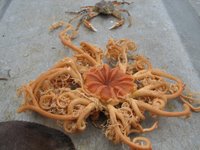
This is a basket star, a kind of sea star. Its branches are hard and are divided into many different branches. The basket star uses all of these to catch plankton. In the center is the mouth.
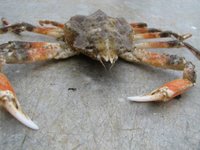
Next, we have a lyre crab.

Have you ever seen a hermit crab without a shell? This one lost his on the way up from the bottom.
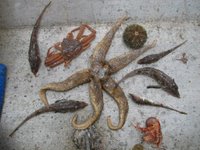
This next photo includes a huge sea star, a sea urchin, a hermit crab without its shell, a tanner crab and several fish called poachers. These fish have scales that are hard, almost like bone or a shell.
This last one is my personal favorite. The fish at the top of the screen is called a big mouthed sculpin. It has the biggest mouth of any fish I’ve ever seen. This fish stays on the bottom waiting for smaller fish to come by, and then… watch out! When it came up in the net, it had a smaller fish in its mouth.
Finally, we brought up a creature called a brittle star. It is a kind of sea star with soft tentacles. It moves very fast for a sea star. The arms can break easily, but don’t worry, they grow back. That’s why they call it a brittle star. Here is a video of a brittle star moving across the lab table.
Later on the same day, our ship was visited by some dall’s porpoises. Click here for a video
Question of the Day
Look at the answer to yesterday’s question. Let’s try another one. If our ship wants to do a trawl 50 meters below the surface, how much wire would it need.
Answer to Yesterday’s Question:
How much wire would the ship need to let out if it wanted to put the nets 200 feet below the surface? Make sure to watch the video on nets before you try to answer the question.
The ship must put out two feet of wire for every one foot of depth. So you have to multiply 200 x 2 which gives 400 feet of wire. Wait, we are not finished yet. Each net has, not one, but three wires holding it to the ship. So you would need 3 wires. All three are 400 feet in length. That gives us 1200 feet of wire to do our trawl.
Answers to Your Questions
Hello to all who wrote today.
The MILLER FREEMAN does seem like home to me now. I have gotten used to the constant rocking of the ship and the routines of the day. I really enjoy being at sea. By the way, they had pizza for lunch, but I asked the cook to make me some fresh pollock that we caught and filleted last night.
Do people eat jellyfish? I asked our chief cook, Mr. Van Dyke. He told me many species of jellyfish are poisonous. Even those that are safe to touch with your hands. So, no, we don’t’ eat them here, but in some countries they do. We have caught many tons of fish, but more importantly, we have seen many fish without catching them using our echosounder. This device allows us to survey fish without capturing so many.
There are 34 people on board with us for this cruise. That will change next week when we get to port.
The squid felt slimy, but not much more slimy than most fish seem. I don’t recall it spraying anything.
Thanks for writing..
Photos:
Various photos from the engine room in NOAA Ship MILLER FEEMAN
Main Engine
Generator
Water treatment equipment
Sewage treatment equipment
A basket star
Various fish from the bottom trawl we did last night
The echosounder return from last night
A lyer crab
A hermit crab
Big mouthed scaulpin
Wednesday, June 14, 2006
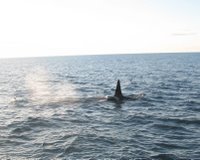
NOAA Ship MILLER FREEMAN
Mission: Bering Sea Fisheries Research
Day 14: June 14, 2006
Weather Data from the Bridge:
Visibility: 14 miles
Wind Speed:14 miles per hour
Sea Wave Height: 3 foot
Water Temperature: 5.3 degrees
Air Temperature: 6.2 degrees
Pressure: 1018 Millibars
Personal Log
A lot of you have been asking about the food on ship. How do we eat? What do we eat? Where do we get our food. All of these are great questions, so yesterday I spent some time with Chief Cook Russell Van Dyke to get some answers for you. He, along with the Chief Steward and the Second Cook, is responsible for preparing all the meals on NOAA Ship MILLER FREEMAN.
How do people eat on a ship? “With a knife and fork,” said our chief cook with a smile. Food is prepared and served on the ship in much the same way that you prepare and serve food at
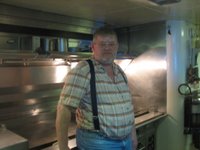
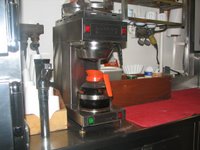 home. The main difference is quantity. Here on the ship, food is prepared for 40 people instead of just a few. “We don’t cook one, chicken, like you do at home,” said Mr. Van Dyke, “we cook 5 chickens. Here are some pictures of where the food is cooked, and where the food is served. On a ship, this is called the galley. Can you see the ring around the coffee pot? Can you guess what that is for? During storms at sea, when the waves are high, that ring keeps hot coffee from flying around the galley. Good idea!
home. The main difference is quantity. Here on the ship, food is prepared for 40 people instead of just a few. “We don’t cook one, chicken, like you do at home,” said Mr. Van Dyke, “we cook 5 chickens. Here are some pictures of where the food is cooked, and where the food is served. On a ship, this is called the galley. Can you see the ring around the coffee pot? Can you guess what that is for? During storms at sea, when the waves are high, that ring keeps hot coffee from flying around the galley. Good idea!Another interesting difference between food on a ship and food at home is that when you are out to see for a month, you cannot run down to the corner to get some milk if you run ou
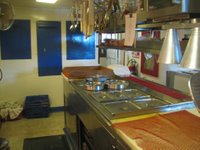 t. Each time
t. Each time 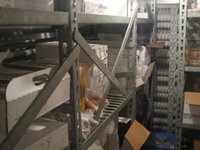 NOAA Ship MILLER FREEMAN is in port, it must take on enough food to last for the entire journey to come. How do they keep all that food? Aside from being a great cook, Mr. Van Dyke and the rest of the crew are also experts in how to store food and keep it from going bad. NOAA Ship MILLER FREEMAN has not one but three refrigerators and two freezers. The refrigerators are kept at slightly different temperatures. The dairy products, like milk and cheese are kept at 37 degrees . The fruits and vegetables are kept in a separate refrigerator at 42 degrees. They keep the humidity in that refrigerator higher as well. Those slightly different conditions help keep the food fresh for a longer period. Meats and ice cream are kept frozen. Dry foods, like cereal are kept in a separate area. Put it all together and the crew on board eat great meals every day. The photo here shows the inside of one of the refrigerators.
NOAA Ship MILLER FREEMAN is in port, it must take on enough food to last for the entire journey to come. How do they keep all that food? Aside from being a great cook, Mr. Van Dyke and the rest of the crew are also experts in how to store food and keep it from going bad. NOAA Ship MILLER FREEMAN has not one but three refrigerators and two freezers. The refrigerators are kept at slightly different temperatures. The dairy products, like milk and cheese are kept at 37 degrees . The fruits and vegetables are kept in a separate refrigerator at 42 degrees. They keep the humidity in that refrigerator higher as well. Those slightly different conditions help keep the food fresh for a longer period. Meats and ice cream are kept frozen. Dry foods, like cereal are kept in a separate area. Put it all together and the crew on board eat great meals every day. The photo here shows the inside of one of the refrigerators.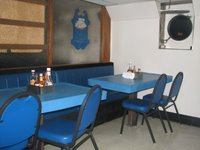
Click below to listen to Chief Cook Russell Van Dyke describe cooking on board a ship:
Where does the ship get its food?
How do you cook on board a ship?
Does the crew have a favorite food?
One more question: Does the crew eat split pea soup? There is a superstition among mariners that cooking split pea soup will bring on a storm. I asked Mr. Van Dyke about it. He told me they eat it all the time. This brave crew last had “storm soup” on May 27th and we may have it again in a few days. I guess the only thing they can’t do on board this ship at sea is have a pizza delivered.
Science Log:
We continue surveying pollock and surveying birds as we move along the transact lines in the Bering Sea. Most of the surveying is being done with the echosounder, but from time to time, we put the nets into the water and trawl for fish. This helps the scientists know more detail about the fish they see on the echosounders. The nets on NOAA Ship MILLER FREEMAN work basically the same way that nets on large commercial trawlers work. We just catch far fewer fish. Would you like to learn more? Click here for a video on the nets.
Question of the Day:
How much wire would the ship need to let out if it wanted to put the nets 200 feet below the surface? Make sure to watch the video on nets before you try to answer the question.
Answer to Yesterday’s Question:
Look at the speed of the ship on this website: About how far would it go in 24 hours? To get your answer, you should multiply the speed you see by 24. Remember to express your answer in nautical m iles. At the moment, the ship is going about 12 nautical miles per hour. At that speed it will travel about 288 miles per day. The real figure will vary because of winds and currents that effect our speed, and because we sometimes stop to fish.
Answers to Your Questions:
I also had an email request from Marcelo for photos with Rusty and I. Here is one. I
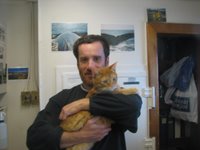 ’m also putting a second photo on to show you one of Rusty’s favorite games. There is a mail slot in the door to the office where he spends a good part of his day. He loves to stick his paw through and introduce himself to passersby. Surprise!!
’m also putting a second photo on to show you one of Rusty’s favorite games. There is a mail slot in the door to the office where he spends a good part of his day. He loves to stick his paw through and introduce himself to passersby. Surprise!!Mrs. McBride, thanks for your kind words.
To my Kindergarten friend, was the squid slimy? YES!!! :)
Photos:

Orca off the port beam.
The coffee pot. See the ring to keep the coffee from flying when the seas get rough?
Chief Cook Russell Van Dyke
The kitchen in NOAA Ship MILLER FREEMAN
The inside of one of the refrigerators. Look how big it is.
The Galley where the crew eat
Rusty, the ships cat and Teacher at Sea Jacob Tanenbaum
Rusty gets the mail







